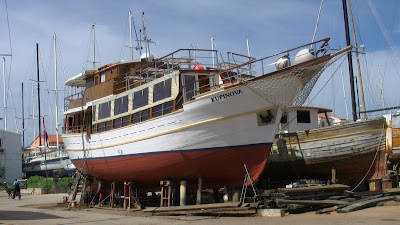 The biggest speedboat in Adriana's fleet, Miro Rudar, has quite a turbulent history.
The biggest speedboat in Adriana's fleet, Miro Rudar, has quite a turbulent history.
Built in the
early '90s, it was one of the boats locally known around Dubrovnik as „smuggler
cigars“. Speedboats of such kind were of very long and sleek design resembling
a cigar, and smugglers used them to smuggle cigarettes across the Adriatic sea.
In the turbulent years of wars of independence, control and regulations by
officials were easily avoided.
During that
period, a number of such high speed vessels were built with only two factors in
mind – big cargo hold and high speed. Smugglers were getting cheaper cigarettes
on the eastern coast and took them under the cover of the night to Italy. At
the time unnamed future Miro Rudar bolstered four engines of 450 hp each and
(beside engines and fuel tanks) spacious hull designed to fit as many cartons
of cigarettes in it as possible.
Thanks to
its powerful engines, such boats were capable of crossing Adriatic sea in just
a couple of hours and thanks to the big price difference between Italy and
Albania/Croatia/Bosna and Herzegovina, such a boat paid off in just two runs.
Every next trip to Italy after that was making basically pure profit.
At the
time, ill-equipped Croatian maritime police had no capabilities of pursuing or
intercepting such boats. Tide has changed when one of the smuggler’s boats
broke down and floated abandoned in Tiha bay in Cavtat. After seizing and
repairing it, police in Dubrovnik finally had a vessel capable of catching up
and seizing other smuggler boats. As many records of those war years are lost,
there is a strong possibility that that first smuggler boat turned into a
police one, under the designation P-203, later became Miro Rudar. While serving
with the police, the boat was tasked with patrol, SAR and control duties.
After the
turn of the millennium, Croatia and its police started to recover and maritime
units started to receive new, purposefully-built boas for their needs and all
seized former smuggler boats became obsolete. They were stripped of useful
equipment and their hulls sold. Adriana Cavtat bought the hull for conversion
which was made locally and by our own talents on the site in Brgat in the
winter ’06-’07.
In the previous
summer, the company suffered a loss of a beloved and valued colleague who was
with us from the new beginning after the war. Miro Rudar was from Zagreb but
was working every summer in the old city port before suffering a stroke. In his
memory, the new ship was named in his honor.
After the completion, some minor flaws were found in the overall stability of vessel and the hull was improved. With the addition of the side extents and with extending the stern, the speedboat is now much more stable, even in the rough seas and with the full load of passengers.
Miro Rudar
now carries two Perkins Sabre engines of 215 hp each and cruises comfortably at
11 miles with the full load of passengers. In some standards brief, but quite
dynamic history of the ship is reflected through the hull lines.






























